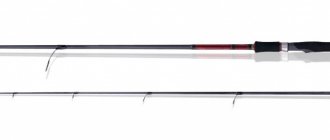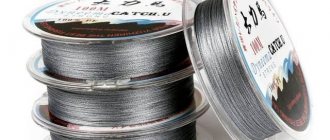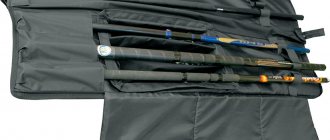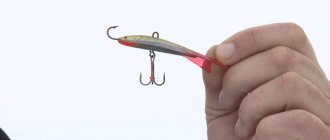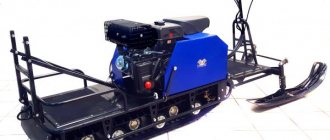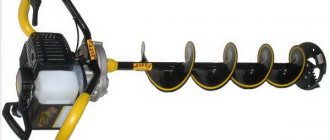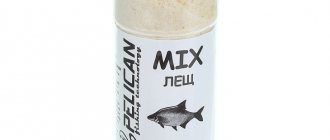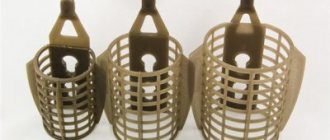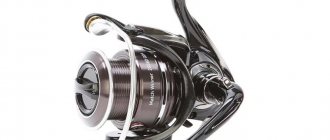What is a quivertype
Feeder tips are bite alarms that can track even the most careful touches of fishing objects. Previously, this function was performed by a thin bamboo rod, but it was not removable. In case of changes in fishing conditions, a more suitable tackle was selected, a replacement had to be made, and when changing a heavy sinker to a light one, and vice versa. So, when using a load with a larger mass, it is necessary to use a rod with a hard whip, and for a load with a smaller mass, a soft tip is required.
When choosing a quivertype, you need to look at both the cost and the workmanship of a particular model. Inexpensive whips often break, which can cause fishing failures. High-quality products do not fail and last a long time with proper use.
Feeder feeders
There are a great variety of feeder weights used in English donkey fishing. Some are used for longer casting, some are equipped with special hooks for better grip on the current. There are just feeding ones. It's easy to get lost in such a variety of choices.
And in this case, experienced fishermen advise not to buy a whole bag of gear at once. There is a high probability that 70% of them will never end up in the reservoir. Start mastering the feeder gradually. Buy several pieces for working weights and learn how to fish with them. Only gradually mastering new models. This way you will save money, and your bag with fishing gear will be lighter!
Test of feeder tips
In the English donkey, the quivertip is not the tip of the tackle, it is only a replaceable addition to it. Regardless of the degree of rigidity, bending of the whip along a stretched fishing line occurs in any case; all the pressure comes to the rod blank.
Considering that the feeder tip is not involved in fishing, pay attention to the fishing tool and its test. Even the most flexible tip can cope with even the heavy weight of the feeder. The feeder tip test is indicated, most often, on expensive models, but maybe not.
Beginners are often mistaken that the choice of quivertype should be made depending on the weight of the feeder, and not on the fishing conditions.
General recommendations for use
The tip is always selected according to the fishing conditions and, most importantly, the net weight of the feeder. And the design of the feeder must correspond to the conditions of the reservoir and weather.
In the case where fishing will take place in still water, it is recommended to install a soft alarm. In windy weather on the lake, as well as for fishing on rivers with weak currents, it is better to use products of medium hardness. But rigid structures are useful when fishing for large fish, as well as in places with strong currents and significant wind.
The expected casting distance also plays a significant role in the operation process. For fishing that does not require long-distance casting of bait, you can use soft and medium-hard signaling devices. But for long-distance fishing, a rigid design is necessary.
Rigidity and sensitivity
In most cases, the rod is already equipped with 2–5 tips. They have varying degrees of sensitivity and rigidity. Tips from popular brands contain this information, indicating sensitivity in ounces (oz), where:
- 0.25 oz = 7 g;
- 0.50 oz = 14 g;
- 0.75 oz = 21 g;
- 1 oz = 28 g;
- 1.5 oz = 42 g;
- 2 oz = 56 g;
- 2.5 oz = 70 g;
- 3 oz = 84 g;
- 4 oz =112 g;
- 5 oz = 140 gr.
High sensitivity (soft) whips are in the 0.5-0.7 oz range. Feeder tips of medium sensitivity and hardness are marked in the range of 1.5-3 ounces, and hard ones, effective for catching large specimens or in unfavorable weather, are marked in the range of 4-6 ounces.
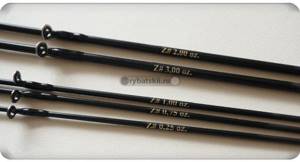
To determine the stiffness of the feeder tip, there is a simple method where you need to hold all the whips between your thumb and forefinger. The one that bends more than the rest will stand out with an increased degree of sensitivity. A rigid quivertype will have the least bending.
What do the colors of the feeder tips mean?
The quiver tip for the feeder is available in different colors. So, the manufacturer indicates the stiffness of the whip:
- green color – soft tip for fishing in reservoirs with calm water/low current;
- yellow/white – tip with a medium degree of hardness for fishing in windy conditions/medium current;
- The red color of the top means the product is quite tough for hunting in strong currents.
To make it easier to navigate the choice of tip for specific fishing conditions, you need to use the softest one first – green. Then, through experimentation, the optimal option is calculated.
What materials are quivertypes made from?
All feeder whips have individual performance characteristics. Taking them into account, you can be guaranteed to purchase a quivertip that best suits your specific fishing conditions.
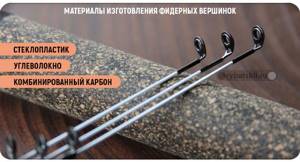
Classification of feeder tips by material:
- Made from fiberglass. This group of whips is in demand due to its low cost and sufficient sensitivity to detect a careful bite. This is a durable material that can withstand heavy loads. The only disadvantage of fiberglass models is their increased softness, which often becomes a source of inconvenience when fishing in extreme conditions - in strong currents. The whip simply bends into an arc, which makes it difficult to control bites. In addition, fiberglass has a tendency to delaminate; such tips must be used carefully, without excessively inflating the dough.
- Made from carbon fiber. Quivertypes are practically free of drawbacks, they are of excellent quality, and are very different from fiberglass ones in cost. They are used mainly in combination with expensive gear. Carbon fiber tips are distinguished by their low weight and sufficient degree of rigidity. During casting, the quivertip does not spread to the sides. It is safely used even in extreme conditions - in windy weather, strong currents.
- From a combined material, where 60% (2/3 of the entire length) of the upper part of the whip is made of solid carbon, the rest is hollow. The quivertip is equipped with thin rings and is used for catching passive fish. Such a tip is capable of recognizing the most timid touches of underwater inhabitants. It is good to use both in windy weather and in strong currents.
Models made of carbon and combined materials are highly sensitive.
Test and classification of feeders
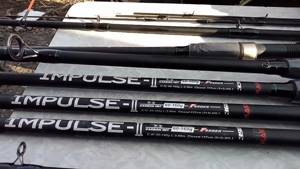
While everything is more or less clear with the concept of a feeder rod test, not all fishermen know what action is and how forms of different action differ. And before choosing the best feeder, you need to understand all the nuances. The rod test is considered to be the optimal mounting weight to be cast into the water.
If the weight of the feeder with bait is greater than the declared test form, then it will break during a force cast.
Manufacturers indicate a test rod with a margin of 20–30 grams, but it is better not to take risks and strictly follow the recommendations. Light rigs are also inconvenient to throw with a rod with solid test, as it will “fail” when casting. What type of rod test is usually indicated directly on the form and this is one of the important selection criteria.
For some feeder models, test limit values are indicated - maximum and minimum, most often in libra (1Lb - 327 grams). It is better for the fisherman to follow the manufacturer’s recommendations, then the rod will last for more than one year.
Experts divide five classes of feeder rods, and although this classification is very arbitrary, it helps to determine the right choice:
- ultra Light feeder – ultra-light;
- light feeder – light;
- medium feeder – medium;
- heavy feeder - heavy;
- extra heavy feeder - extra heavy.
This classification is recognized by manufacturers and a mark about the class of the feeder rod is placed on the form. Ultra Light feeder is designed for fishing with feeders weighing up to 40 grams in still water.
The length of such fishing rods does not exceed 3 meters and they are made from:
- carbon fiber;
- fiberglass;
- composites.
Ultralight rods are not designed for long-distance power casting. But in conducting exploratory fishing at close ranges, such forms show their best side.
The maximum length of the light feeder is 330 cm, and the test weight is up to 60 grams. Such parameters allow for comfortable fishing at distances of up to 60 meters, not only in lakes and stakes, but also on rivers
Inexperienced fishermen should pay attention to forms of this class, because this is, in fact, a feeder rod for beginners and it is better to learn feeder fishing with it
Medium feeder is the largest class of feeder forms. The length of the mediums is up to 360 cm, the test weight is up to 100 grams, and these are already solid characteristics that allow you to catch trophy fish at distances of up to 80 meters. The high sensitivity of medium-class feeders is important, and when fishing, they “knit” the fish well, preventing it from getting off the hook. Such rods can withstand forceful casting and are sensitive to the most “gentle” fish bites.
Heavy class feeders are aimed at catching strong fish on large rivers with turbulent currents, where their advantages are fully demonstrated. Test forms up to 120 grams, length up to 390 cm, fishing distance 120+ meters. High-quality heavy feeders are made of carbon, because this allows, along with reliability and power, to minimize the weight of the form and provide convenience when working with it.
Heavy class rods are also used for fishing on still commercial reservoirs, where there are definitely trophy fish, but to catch them, you need power casts over a long distance. The blank of the rod handles the jerks of trophy fish well and forgives the angler for possible mistakes when fishing.
Along with mediums, heavy feeders are very popular among fishermen and companies producing feeder equipment are trying to constantly expand their offer in this niche.
You need to understand that heavy class feeders are inconvenient for close-range fishing with light feeders. The load on the rod must correspond to its class.
Feeder rods of the extra heavy class are the most powerful equipment for fishing in difficult conditions. If you have to fish on a river with a strong current, you need to use heavy feeders that ensure that the food is thrown at the same point all the time, because they are not carried away by the flow of water. But to cast a heavy feeder you need a powerful blank that can withstand heavy loads. Extra-heavy feeders are the heaviest, but this is not surprising considering the tasks they perform.
Length and diameter of feeder tips
The degree of rigidity is determined by the length of the whip. Thus, a long tip for a feeder with a small diameter will have less rigidity in contrast to a short whip.
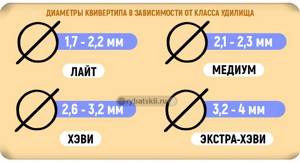
To obtain a catch, it is necessary that the landing diameter of the quiver tip matches the feeder used:
- for light rods – from 1.7 to 2.2 mm;
- for medium class instruments – from 2.1 to 2.3 mm;
- for heavy class feeders – from 2.6 to 3.2 mm;
- for extra-heavy class models – from 3.2 to 4 mm.
On the fishing accessories market there are quivertypes from well-known manufacturers, which are made in a standard diameter. So, Shimano's feeder tips have a seat diameter of 2.3 mm.
Picker or ultra light
The lightest and most sensitive small feeder. Rod length is from 2 to 3 meters, test 20-40 grams. This feeder is not intended for long-distance power casting, and its test does not allow the use of a feeder. Feeding the point is done manually, the fishing distance is 20-40 meters.
Read: Fishing on a feeder
Ideal for fishing in small bodies of standing water: ponds, oxbow lakes, small lakes. Equipped with a monofilament line and sinker corresponding to the test.
Passing rings
To increase comfort, feeder whips are equipped with passage rings. They can be made from ceramics and silicon carbide (SIC). If monofilament is used in the fishing process, then the material of construction does not play a significant role here.
When using a braided cord, preference should be given to silicon carbide guide rings, otherwise the appearance of cuts on the ceramic cannot be avoided. SIC inserts are structures that are resistant to the effects of rigid braids. But due to the fragility of the material, they must be handled carefully, otherwise there is a high probability of them splitting.
The larger the diameter of the guide rings, the more effective the long cast, and the less debris collects on the main line. What is quivertype locking and how to solve this problem
By locking the tip we mean its flying out of the seat. To eliminate this nuisance, you need to accurately select the whip. Ideally, you should purchase the tip from the same manufacturer as the feeder itself. You can take the rod with you to the store and check on the spot that there is no play. The main thing is that the tip should “sit tightly”, then its level of information content will be at its best.

Sometimes it is not possible to buy a whip with a specific seat diameter, then you can use the following technique:
- Purchase a tip with a thickness as close as possible to the desired model.
- Wrap the braid around the butt.
- Cover with varnish.
To reduce the thickness of the quivertype, use fine-grained sandpaper.
Physical properties influencing choice
General factors influencing the choice of quivertype for a feeder:
- design and weight of the feeder;
- current speed;
- the diameter of the main line or cord used;
- features of the bottom and its structure;
- wind power.
Another common misconception about quivertips is that they are selected based on casting power or fishing distance. In fact, the tip is not involved in the process of casting the equipment, and the load falls on the feeder rod.
Therefore, when casting, the structure of the blank and its physical characteristics are important, and not the quiver tip test, or the material from which it is made. Fishing distance plays a role when choosing a tip, but it is not the only factor that is taken into account.
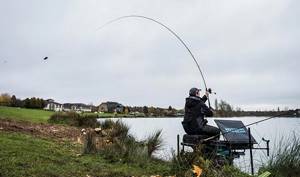
The manufacturer supplies each feeder rod with up to five interchangeable tips, with the corresponding diameter of the seat.
Different models of feeders have different diameters of the top seat and this is taken into account when choosing and purchasing.
Rigidity
The tips we offer differ in hardness, measured in ounces (oz), or grams. One ounce is equal to 28 grams and based on this, it is easy to calculate the indicator for each quivertype.
To make it easier to recognize the stiffness of the whips, color marks are used, and the following are supplied with the feeder:
- yellow;
- red;
- green;
- white.

There are other colors, but the ones listed above are the most popular and common. Do not be surprised if the test is not indicated on the whip, because some manufacturers of feeder rods consider its indication optional. In this case, they focus on the color of the tip and its thickness, which is even easier than using numbers.
It is important to understand that the tip test is in no way related to the rod test and its stiffness does not depend on whether the blank is produced by a well-known European company or an unfamiliar Chinese manufacturer. A quivertip is a bite alarm, and not a part of the rod involved in casting and retrieving fish, as is the case, for example, with carp blanks.
A quivertip is a bite alarm, and not a part of the rod involved in casting and retrieving fish, as is the case, for example, with carp blanks.
The most flexible tip is green, and the stiffest is red; the rigidity of the remaining whips is average, if they are supplied in the kit. For those who do not conduct serious research and prefer not to complicate their lives with information about the test and hardness, it is recommended to start fishing with the most sensitive, green tip and experiment, choosing the best option.
In sport fishing with a feeder, the sensitivity of the tackle plays a very important role, since in competitions mainly small fish are caught and every 100 grams of weight become decisive in the final protocol. Here it is impossible to miss the most delicate bite, and a whip with minimal rigidity is selected.
If during the competition it turns out that a more rigid quivertip is required for the existing conditions, it is better to make a replacement in a timely manner, because this will clearly improve the result and increase the catch, all other things being equal.
For amateurs, the correct choice of tip is not so critical, but even in this case, the delicacy of the tackle is important. Thanks to a well-chosen whip, careful bites are clearly visible, and you are guaranteed to increase both the number of your trophies and their size.
Which quivertip to use when fishing?
To ensure successful feeder fishing, follow these tips regarding choosing a quivertype:
- If fishing is planned on a reservoir with calm water, and the object of fishing is a small fish, then a tip with a dough of 0.5-1 ounces is suitable. These are green whips.
- For fishing in areas with moderate currents, slow rivers, where hunting is carried out for carp, bream, and medium-sized tench, use whips with 1.-2 ounces of dough. These are feeder tips, colored yellow-orange.
- To catch carp, carp, tench or chub, use quivertips with up to 3 ounces of white dough.
- If fishing will take place at a considerable distance from the coastline or using method feeders, then preference should be given to whips with a dough of 4 ounces or more. Such tips are also suitable for fishing in strong currents, when catching trophy carp, carp, chub, ide and other large specimens. These are red tops.

A correctly chosen quiver tip for feeder fishing is the key to a highly informative tackle, which will make it possible not to miss even the most cautious fish bite. Spare tips should be stored in a hard tube to prevent damage during transportation. Before going fishing, take into account the quivertype test, it is determined according to the fishing conditions. With careful use, the tips will last for more than one season.
All about quivertips for feeder fishing. How to choose the right quivertypes
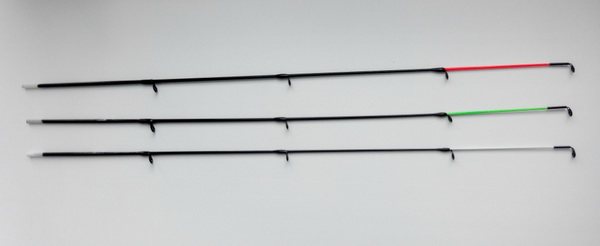
Our topic today will be feeder tips or, as they are also called, quivertips. We will discuss what they are, how they differ, what their test means, and how to select a tip for a feeder depending on the fishing conditions.
You can also find more modern ones on sale: hollow and combined tips. Expensive feeder rods are equipped with such tips; a beginner is unlikely to take such forms. They are often purchased by experienced feeders who know how to choose the right feeder.
Soft and sensitive feeder tips are made mainly of fiberglass (0.5 and 1) oz, but harder ones (1.5-4 oz) can be either fiberglass or carbon fiber.
Fiberglass tops are very soft and bend almost completely during loading. They work great on cautious fish, as they swallow the bait with virtually no resistance. Due to their elasticity, these tips dampen the jerks of large fish, reducing the likelihood of the gear breaking. Many carp anglers have long opted for a fiberglass tip for their feeder, equipping their forms with powerful (3-4 oz), but still fiberglass quivertips. They also try to equip method rods with such tips.
But fiberglass tips also have their drawbacks; with strong waves and wind, there is a possibility of false alarms. Due to their softness, the accuracy of these tips is slightly lower than that of carbon ones. Also, when using fiberglass tips, you must ensure that there is no bending of the tip, otherwise this may lead to breakage.
Carbon-fiber (carbon) tips bend only in their upper part and perfectly resist wind and current. At the same time, the rigidity of the carbon tips does not allow them to absorb the jerks of the fish, which can lead to breakage of the leads. A partial solution to this problem may be the use of feeder gum.
In order to determine what material the tip of the feeder rod is made of, just look at its base; if the tail is white, it means fiberglass, black – carbon. Also, information about the material can be applied to the tip itself. Feeder tips
Hollow feeder tips, or as they are also called Hollow Tips, are made of carbon fiber (carbon fiber) and combine the advantages of both carbon fiber and fiberglass. That is, they have high sensitivity, not inferior to fiberglass tips and at the same time, when casting, do not bend into an arc like carbon tips. Thanks to the hollow quivertips, lighter feeders can be used.
Splised-Tip combination tips with 60% of the top section being solid carbon and the rest being hollow. This tip is equipped with very thin rings and is capable of transmitting signals even with very weak bites. This choice of tip for the feeder will allow you not to be left without a catch even with passive fish.
Feeder tips - sensitivity and rigidity Feeder forms are often equipped with three tips that have different degrees of sensitivity. Of course, you can find forms with one, two or four feeder tips, but mostly manufacturers equip their rods with 3 types of tips. Choosing a tip for a feeder
The sensitivity of the feeder tip depends on such a parameter as the test, which is indicated in ounces - oz (1 ounce equals 28 grams). The lower this value, the more sensitive the quivertype.
If you purchased a feeder with three tips, on which it is written 1.5, 2, 2.5 oz, this means that the 2.5 oz tip is the hardest, and the 1.5 oz tip is the softest.
Some feederists mistakenly believe that the feeder tip test means the maximum weight of the equipment, under the load of which you can not be afraid of damaging the quivertip. Of course, this is not true, because if we look at the tip, we will see a large number of rings, thanks to which the load is evenly distributed throughout the tip, making it a continuation of the fishing line, which makes the tip difficult to break.
It happens that you bought a feeder rod, but there are no markings on its tips; in this case, you can determine which of the tips is softer and which is harder in the following way. We take all our tops by the tip of the tulip (see picture) and see that their bases have taken different positions:
The topmost tip is the hardest; the middle is medium; The softest one is at the bottom. You will also need this method when you decide to buy additional tips for the blank, since very often a tip with dough, for example 1 ounce, from different manufacturers will have different degrees of hardness. quivertip
When choosing a tip for a feeder, it is worth paying attention to its length, which affects the quality of the structure. So, if the quivertype you choose turns out to be too short, this will negatively affect the overall structure of the rod. When a load is applied, at the junction of the tip and the blank, you will see a clearly visible fracture.
Excessively long feeder tips reduce the range of the form, due to the fact that their upper part behaves unstable.
The optimal length of feeder tips, at which the action of the rod remains smooth and clean, even during long casts of heavy feeders, varies in the range of 55-75 cm.
Basic tips for choosing a tip for a feeder The main factors influencing the choice of a tip are the strength of the current and the wind. The main task of the tip is to fix the bite. Therefore, the softer the tip, the more sensitive it is. Everything seems simple, but at the same time it is necessary to take into account factors such as wind and current strength, in the presence of which an excessively soft tip will bend strongly, preventing you from noticing a bite.
The basic rule is this: we always set the softest tip, but with an eye to the circumstances (strength of the current, wind and casting distance).
For example, you are fishing on a stagnant pond with a weak wind, put on the softest tip, if over time the wind gets stronger and your tip starts to bend, then put on a stiffer one, it happens that in strong winds the tip is 0.5 ounces, changed to a tip of 2 ounces. Here, however, it is necessary to take into account the total weight of the equipment; if you put an excessively rigid tip on a light feeder, then with the slightest movement of the rod we will pull it out of place. quivertip
A soft feeder tip has less accuracy when casting than a hard one, so in order for you to have a high-quality feeding spot when fishing long-distance, harder tips are used. You won’t lose much in sensitivity, since the farther you are from the shore, the more confidently and boldly the fish takes.
Beginners should choose a stiffer tip for the feeder, since it is better to miss one or two bites than to waste the bait over a large area of the reservoir due to lack of practice.
For fishing at medium and short distances up to 25-30 m, a tip with 1 oz dough is sufficient, which will allow you to throw a 40 gram feeder fully loaded with bait with good accuracy.
For long casts, feeder tips with 1-1.5 ounces of dough work.
Quivertips with 2-3 ounces of dough are designed for fishing with maximum long casts in reservoirs, as well as for fishing on rivers with medium and weak currents.
Tops with dough of 3 ounces and above are intended for rivers with strong currents. For example, you come to a river like the Oka, where there is a strong current and you need to use only heavy feeders weighing about 120-140 grams, then we take the stiffest tip that is available, it will still bend it completely, right up to the second knee of the rod.
We usually have the most problems with choosing a tip on reservoirs with medium currents, when not everything is so simple. The tip in its normal position should be slightly bent, but in no case at an angle of 90 degrees, the normal bending angle is 30-45 degrees. Feeder tip
Separately, I would like to note that when fishing with a feeder in the fall, when the fish moves away from the shore and its activity decreases, hard feeder tips will not allow you to react to sensitive bites. In this case, the right decision would be to choose hollow and combined quivertypes.
Passing rings When choosing a top for a feeder, you need to pay attention to the insertion material of the pass rings; inexpensive ends have ceramic inserts in the rings. They are suitable for fishing with monofilament, but if you decide to use braid, it will eventually cut ditches into them.
For braided cord, tips are suitable that have inserts in their rings coated with Gold Cermet titanium nitride, SiC silicon carbide or aluminum oxide.
Having decided to buy several additional tips or replace a broken one, you will definitely come across such an issue as the landing diameter, which seriously affects the choice of a tip for the feeder. The fact is that rods of different classes have different diameters, and even rods of the same class from different manufacturers have different sizes. Quivertip
Approximate landing diameter of quivertips depending on the class of the rod:
Light (picker) - 1.7-2.3 mm; Medium - 2.1-2.3 mm; Heavy class (Heavy) - 2.6-3.2 mm; Extra Heavy - 3.2-4 mm; Gradually, manufacturers are trying to unify the standards of landing tips, so the Shimano company for all its blanks produces tips with a landing diameter of 2.3 mm, so you can take a 0.5 oz tip from a picker and put it on a heavyweight. This is very convenient when you catch passive fish in a still body of water, but need to cast far.
You should not purchase quivertypes of large diameters in order to adjust their diameter by grinding with a sander or knife, this will not give the result you expect.
Feeder tips are a very important element of equipment and the choice must be approached with the utmost care.
Read other articles, reviews and testimonials:
- Catching sabrefish on a feeder. How to properly catch saberfish on a feeder.
- Review of the Kaida Albatron 30-120 feeder. Reviews from fishermen about the Kaida Albatron feeder
- Donk fishing. What is donka? How to fish with a donk correctly?
- Review of the Salmo Taifun Feeder. Reviews from fishermen about the feeder Salmo Typhoon Feeder
- Review of the Salmo Elite Feeder. Reviews from fishermen about the feeder Salmo Elite Feeder

